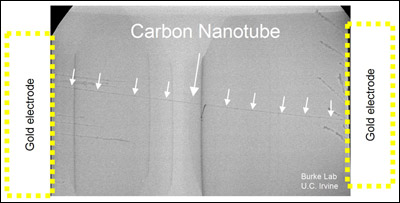UC Irvine Scientists Develop World's Longest Electrically Conducting Nanotubes
|
Breakthrough Discovery Is 10 Times Longer Than Previous Current-Carrying Nanotubes, Paves Way For Supercomputer And Health Care Applications Irvine, Calif., Oct. 18, 2004 - UC Irvine today announced that scientists at The Henry Samueli School of Engineering have synthesized the world's longest electrically conducting nanotubes. These 0.4 cm nanotubes are 10 times longer than previously created electrically conducting nanotubes. This breakthrough discovery will lead to the development of extremely strong, lightweight materials and ultradense nano-memory arrays for extremely powerful computers, ultralow-loss power transmission lines, and nano-biosensors for use in healthcare applications. A nanotube is commonly made from carbon and consists of a graphite sheet seamlessly wrapped into a cylinder only a few nanometers wide. A nanometer is one billionth of a meter, about the size of 10 atoms strung together. Peter Burke, assistant professor of electrical engineering and computer science, conducted the research along with graduate students Shengdong Li, Christopher Rutherglen and Zhen Yu. "We are extremely excited about this discovery," said Burke. "Recently there have been several key advances around the world in synthesizing very long carbon nanotubes. Our research has taken a significant step forward by showing we can pass electricity through these long nanotubes. Significantly, we have found that our nanotubes have electrical properties superior to copper. This clearly shows for the first time that long nanotubes have outstanding electrical properties, just like short ones." Researchers grew the carbon nanotubes using a simple procedure: Burke allowed natural gas to react chemically with tiny iron particles or "nanoparticles" inside a small furnace. By placing a small amount of gold under the iron, Burke's group found that ultralong nanotubes grow; whereas without the gold, only short nanotubes grow. Because nanotubes are so small, it is difficult to connect regular wires to them. By using gold in the growth process, Burke solved this problem by growing nanotubes that come out already attached to gold wires. An added scientific benefit is that Burke was able to accurately determine how the electrical resistance of a nanotube depends on its length. The relationship between resistance and physical size (length) is a key property for any new material. Burke's finding indicates that the electrical conductivity is greater than copper wires of the same size, a world record for any nano-material of this length. The findings are reported in the September issue of Nano Letters, a peer-reviewed journal of the American Chemical Society, the world's largest scientific society. The Army Research Office, the Office of Naval Research, the Defense Advanced Research Projects Agency, and the National Science Foundation provided funding for this research. The project work took place at UC Irvine's Integrated Nanosystems Research Facility in The Henry Samueli School of Engineering. About The Henry Samueli School of EngineeringThe Henry Samueli School of Engineering numbers nearly 3,000 students and 95 faculty members across five academic departments: biomedical engineering, chemical engineering and materials science, civil and environmental engineering, electrical engineering and computer science, and mechanical and aerospace engineering. The school is home to numerous research centers, including the Center for Pervasive Communications and Computing, the Integrated Nanosystems Research Facility, the National Fuel Cell Research Center and the Center for Biomedical Engineering. It is a major participant in the California Institute for Telecommunications and Information Technology. For more information, please visit www.eng.uci.edu. About the University of California, IrvineThe University of California, Irvine is a top-ranked public university dedicated to research, scholarship and community service. Founded in 1965, UCI is among the fastest-growing University of California campuses, with approximately 24,000 undergraduate and graduate students and about 1,300 faculty members. The third-largest employer in dynamic Orange County, UCI contributes an annual economic impact of $3 billion.
|


